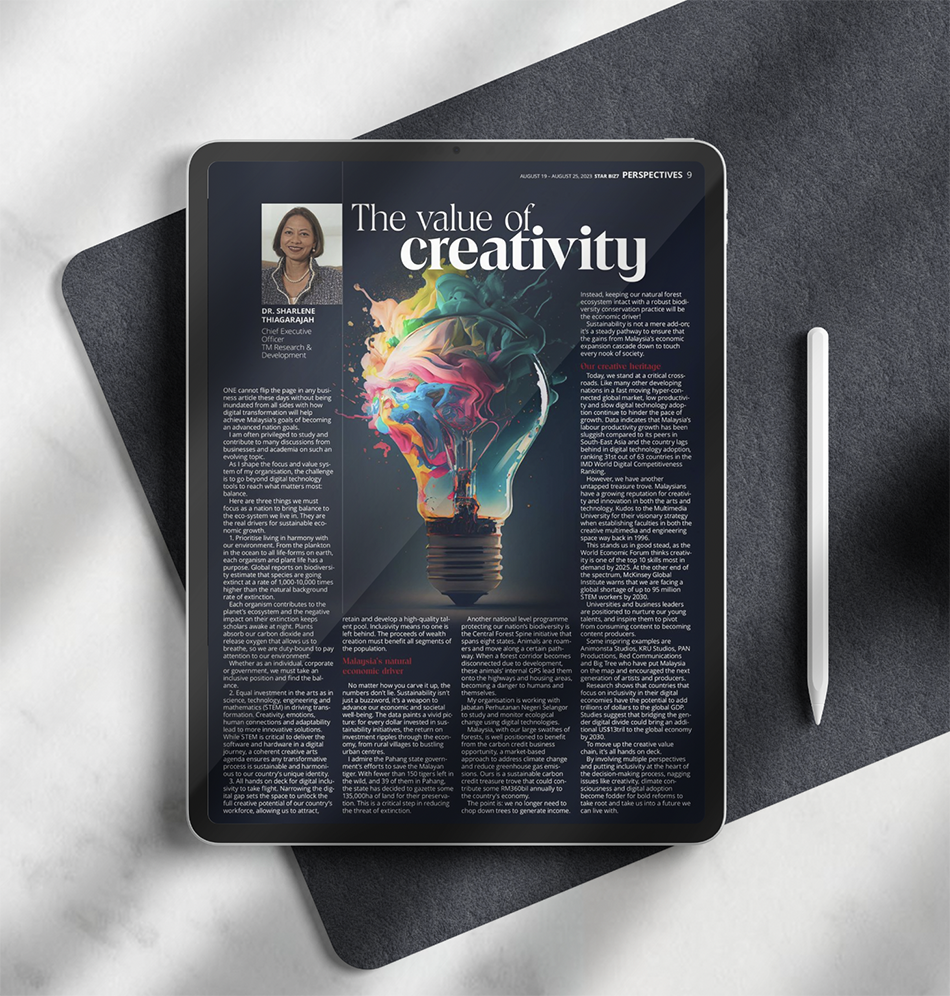
One cannot flip the page in any business article these days without being inundated from all sides with how digital transformation will help achieve Malaysia’s goal of becoming an advanced nation goals.
I am often privileged to study and contribute to the many discussions from businesses and academia on such an evolving topic.
As I shape the focus and value system of my organisation, the challenge is to go beyond digital technology tools to reach what matters most: balance.
Here are three things we must focus as a nation to bring balance to the eco-system we live in. They are the real drivers for sustainable economic growth.
- Prioritise living in harmony with our environment. From the plankton in the ocean to all life-forms on earth, each organism and plant life has a purpose. Global reports on biodiversity estimate that species are going extinct at a rate of 1,000-10,000 times higher than the natural background rate of extinction.
Each organism contributes to the planet’s ecosystem and the negative impact on their extinction keeps scholars awake at night. Plants absorb our carbon dioxide and release oxygen that allows us to breathe, so we are duty-bound to pay attention to our environment.
Whether as an individual, corporate or government, we must take an inclusive position and find the balance.
- Equal investment in the arts as in science, technology, engineering and mathematics (STEM) in driving transformation. Creativity, emotions, human connections and adaptability lead to more innovative solutions. While STEM is critical to deliver the software and hardware in a digital journey, a coherent creative arts agenda ensures any transformative process is sustainable and harmonious to our country’s unique identity.
- All hands on deck for digital inclusivity to take flight. Narrowing the digital gap sets the space to unlock the full creative potential of our country’s workforce, allowing us to attract, retain and develop a high-quality talent pool. Inclusivity means no one is left behind. The proceeds of wealth creation must benefit all segments of the population.
Malaysia’s natural economic driver
No matter how you carve it up, the numbers don't lie. Sustainability isn't just a buzzword, it’s a weapon to advance our economic and societal well-being. The data paints a vivid picture: for every dollar invested in sustainability initiatives, the return on investment ripples through the economy, from rural villages to bustling urban centres.
I admire the Pahang state government’s effort to save the Malayan tiger. With fewer than 150 tigers left in the wild, and 39 of them in Pahang, the state has decided to gazette some 135,000 ha of land for their preservation. This is a critical step in reducing the threat of extinction.
Another national level programme protecting our nation’s biodiversity is the Central Forest Spine initiative that spans eight states. Animals are roamers and move along a certain pathway. When a forest corridor becomes disconnected due to development, these animals’ internal GPS lead them onto the highways and housing areas, becoming a danger to humans and themselves.
My organisation is working with Jabatan Perhutanan Negeri Selangor to study and monitor ecological change using digital technologies.
Malaysia, with our large swath of forests, is well positioned to benefit from the carbon credit business opportunity, a market-based approach to address climate change and reduce greenhouse gas emissions. Ours is a sustainable carbon credit treasure trove that could contribute some RM360bil annually to the country's economy.
The point is: we no longer need to chop down trees to generate income. Instead, keeping our natural forest ecosystem intact with a robust biodiversity conservation practice will be the economic driver!
Sustainability is not a mere add-on; it's a steady pathway to ensure that the gains from Malaysia's economic expansion cascade down to touch every nook of society.
Our creative heritage
Today, we stand at a critical crossroads. Like many other developing nations in a fast moving hyper-connected global market, low productivity and slow digital technology adoption continue to hinder the pace of growth. Data indicates that Malaysia's labour productivity growth has been sluggish compared to its peers in South-East Asia and the country lags behind in digital technology adoption, ranking 31st out of 63 countries in the IMD World Digital Competitiveness Ranking.
However, we have another untapped treasure trove. Malaysians have a growing reputation for creativity and innovation in both the arts and technology. Kudos to the Multimedia University for their visionary strategy when establishing faculties in both the creative multimedia and engineering space way back in 1996.
This stands us in good stead, as the World Economic Forum thinks creativity is one of the top 10 skills most in demand by 2025. At the other end of the spectrum, McKinsey Global Institute warns that we are facing a global shortage of up to 95 million STEM workers by 2030.
Universities and business leaders are positioned to nurture our young talents, and inspire them to pivot from consuming content to becoming content producers.
Some inspiring examples are Animonsta Studios, KRU Studios, PAN Productions, Red Communications and Big Tree who have put Malaysia on the map and encouraged the next generation of artists and producers.
Research shows that countries that focus on inclusivity in their digital economies have the potential to add trillions of dollars to the global GDP. Studies suggest that bridging the gender digital divide could bring an additional US$13tril to the global economy by 2030.
To move on up the creative value chain, it’s all hands on deck.
By involving multiple perspectives and putting inclusivity at the heart of the decision-making process, nagging issues like creativity, climate consciousness and digital adoption become fodder for bold reforms to take root and take us into a future we can live with.
This article was first published in the Star Biz7, Issue 6 – Unbundling the progressive wage model
To access the PDF version, Click Here
To read the full Star Biz7 digital magazine, Click Here

